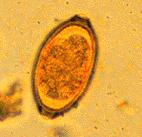Difference between revisions of "Capillaria"
| Line 13: | Line 13: | ||
}} | }} | ||
| − | =Overview= | + | ==Overview== |
[[Image:Capilaria.jpg|thumb|right|150px|''Capillaria'' - Courtesy of the Laboratory of Parasitology, University of Pennsylvania School of Veterinary Medicine]] | [[Image:Capilaria.jpg|thumb|right|150px|''Capillaria'' - Courtesy of the Laboratory of Parasitology, University of Pennsylvania School of Veterinary Medicine]] | ||
''Capillaria spp.'' are similar to other members of the Trichuroidea superfamily such as ''Trichuris'' but with slight differences in morphology of the anterior and posterior ends. Although they are found in domestic mammals these species are of greatest importance in birds. The predilection sites vary between species and are not restricted to the gastrointestinal system. Important species include; ''C. annulata'', ''C. anatis'' and ''C. contorta''. | ''Capillaria spp.'' are similar to other members of the Trichuroidea superfamily such as ''Trichuris'' but with slight differences in morphology of the anterior and posterior ends. Although they are found in domestic mammals these species are of greatest importance in birds. The predilection sites vary between species and are not restricted to the gastrointestinal system. Important species include; ''C. annulata'', ''C. anatis'' and ''C. contorta''. | ||
| − | =Identification= | + | ==Identification== |
| − | Capillaria are extremely thin, filamentous worms measuring 15-25mm long in males and 35-80mm long in females. Males have a single spicule and many have a primitive bursa like structure | + | Capillaria are extremely thin, filamentous worms measuring 15-25mm long in males and 35-80mm long in females. Males have a single spicule and many have a primitive bursa like structure. The eggs have bipolar plugs and thick shells, the size can vary between species. |
| + | |||
| + | ==Important Species== | ||
| + | ===''C. annulata''=== | ||
| + | This species affects many species of wild birds as well as domesticated poultry and ducks. The predeliction site for this worm is the oesophagus of the bird where it will bury the anterior end into the mucosa causing inflammation. High levels can resulted in marked thickening of the oesophageal wall and can be fatal. | ||
| + | |||
| + | ===''C. contorta''=== | ||
*''Capillaria aerophila'' in [[Respiratory Parasitic Infections - Pathology#Capillaria aerophila|respiratory disease]] of cats and dogs[[Category:Trichinelloidea]] | *''Capillaria aerophila'' in [[Respiratory Parasitic Infections - Pathology#Capillaria aerophila|respiratory disease]] of cats and dogs[[Category:Trichinelloidea]] | ||
Revision as of 12:25, 29 July 2010
| Capillaria spp. | |
|---|---|
| Kingdom | Animalia |
| Phylum | Nematoda |
| Class | Adenophorea |
| Sub-class | Enoplia |
| Order | Trichurida |
| Super-family | Trichuroidea |
| Family | Trichinellidae |
| Genus | Capillaria |
| Species | Many |
Overview
Capillaria spp. are similar to other members of the Trichuroidea superfamily such as Trichuris but with slight differences in morphology of the anterior and posterior ends. Although they are found in domestic mammals these species are of greatest importance in birds. The predilection sites vary between species and are not restricted to the gastrointestinal system. Important species include; C. annulata, C. anatis and C. contorta.
Identification
Capillaria are extremely thin, filamentous worms measuring 15-25mm long in males and 35-80mm long in females. Males have a single spicule and many have a primitive bursa like structure. The eggs have bipolar plugs and thick shells, the size can vary between species.
Important Species
C. annulata
This species affects many species of wild birds as well as domesticated poultry and ducks. The predeliction site for this worm is the oesophagus of the bird where it will bury the anterior end into the mucosa causing inflammation. High levels can resulted in marked thickening of the oesophageal wall and can be fatal.
C. contorta
- Capillaria aerophila in respiratory disease of cats and dogs
- In nasal passages, sinuses, trachea and bronchi of cats and dogs
- Some dogs cough but often no symptoms
- Mild catharral inflammation
- In heavy infestation may cause obstruction of the lumen of airways and may develop into secondary bronchopneumonia
